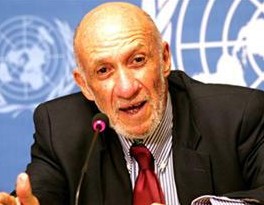- Home>
- U.N. Sounds Alarm on Unsecured Uranium Waste in Tajikistan
Sunday, December 16, 2012
The United Nations warned Friday that nearly 55 million tonnes of radioactive waste from old Soviet-era uranian mines remain in unsecured sites in northern Tajikistan.
The former Soviet republic, where Stalin's empire once mined uranium to create its first nuclear bomb, is still stuck with about 54.8 million tonnes of unsecured waste from the now mainly abandoned mines, the United Nations Economic Commission for Europe (UNECE) said.
The waste is "not treated, not confined, not secured," agency spokesman Jean Rodriguez told reporters in Geneva.
In its second environmental performance report for the country, the U.N. agency lamented the lack of progress made to clean up the radioactive waste, which it said appeared to remain at the same level as in 1990.
"The state of radioactive waste storage is one of the main problems in Tajikistan," it said, noting that a number of the unsecured sites are near Khujand, Tajikistan's second largest city.
The largest single dump site contains 12 million tonnes of radioactive waste and is in the town of Taboshar, north of Khujand, the report showed.
The uranium used when the first Soviet nuclear bomb was successfully tested on August 29, 1949, was extracted in northern Tajikistan.
Uranium from Kyrgyzstan and Uzbekistan was also processed for decades near Khujand, and 35,000 cubic metres of low-level radioactive waste accumulated there, according to UNECE
The health risks associated with exposure to uranium are well-known. According to the U.S. Department of Energy, sustained exposure can result in kidney damage and an increased risk of cancer.
UNECE praised the International Atomic Energy Agency (IAEA) for trying to set up projects to help the country manage its radioactive waste, but stressed that "due to the magnitude of the problem, it is hard to envisage that this issue will be solved in the foreseeable future."
(Source) AFP
